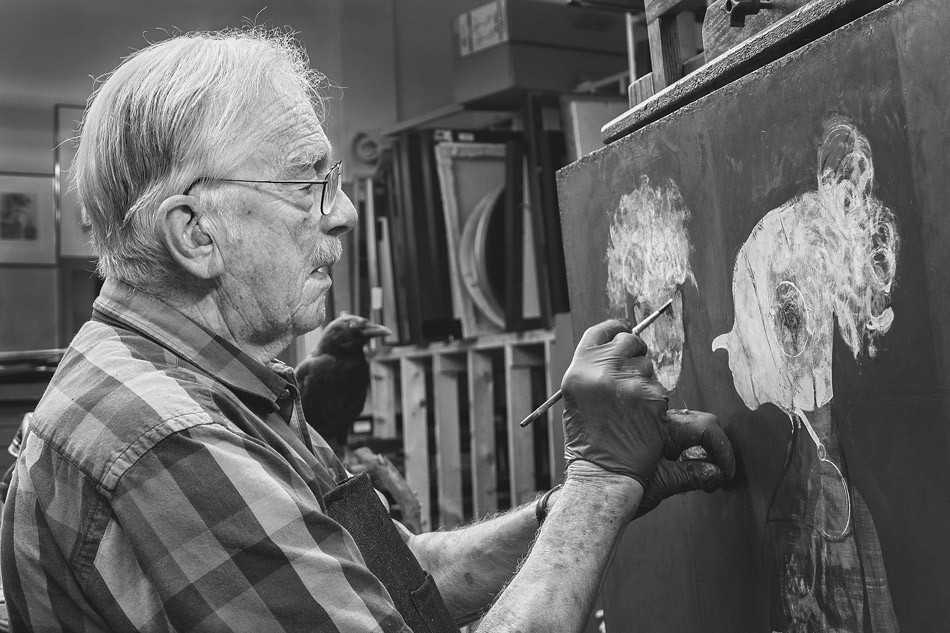Robert Ernst Marx's sculptures, prints, and paintings are populated with weatherworn humans. They are portraits of nonspecific people and of the intangible things we all carry; they are some of the loveliest depictions of the fragility and resilience of humanity. A new exhibition of Marx's work opened recently at Rochester Picture Frame, held in celebration of the artist's 60 years of showing his art and his nearly 90 years of life.
Across each medium he uses, Marx's work is impressively identifiable as his own. For six decades, he has created etchings, bronze and porcelain sculptures, oil paintings, and drawings using charcoal, pencil, and pen and ink. His work has been collected by 88 museums, libraries, and rare book rooms in the United States and Europe, as well as more than 50 private galleries. Marx has also created 14 books and portfolios of etchings and hand-set type of various local and international writers. This new show features 62 artworks, including paintings, etchings, drawings and unique sculptures.

- photo by John Solberg
- The work of Robert Ernst Marx (pictured in his studio) is currently featured in a show at Rochester Picture Frame, in celebration of sixty years of making art.
His paintings are dominated by subdued earth tones that are punctuated by saturated pops of rusty orange or emerald, and the occasional clean white garment floating like a bright specter above the earthly mire. Gentle texture is added with patterns and scratches, and in sketchy markings that help fade the features into the background.
But the features don't go quietly. In each work, there is a tension between flatness and areas of depth and dimension and sharp definition. In 2D and 3D work alike, indistinct territories resolve into a sharpness of some features: beak-like noses, sharp ears, portal-like eyes, or thin lines of mouths provided a hard edge to the turbulent rest.
These works of art express Marx's fundamental theme, "The Arrogance of Power." He says he is troubled by "the exclusivity of the institutions of church and state, abuse by and of both spouse and child, and our own and others' personal fears and insecurities. We are also to some degree trapped by conventions we impose on ourselves."
Many paintings, prints, and drawings are of faces or busts, titled with names that Marx may have given the muse. "Sometimes you see an individual...that individual's name should be Brian or Sabina or whatever occurs," he says. "I do not know any of my 'portrait' people. In fact while these are being painted, I am thinking how to paint an emotion, an eye, does a particular distortion of the painting help convey that emotion. So in effect, these are in the "practice" category, much like a piano etude, which hones a particular appropriate skill."
Much of this skill-honing has to do with the masterful conveyance of nameless emotions. The people are relatable in that they are half hollow, they have been pressed flat by implied forces. They are burdened, changed, altered; they are heavy or mere wisps, but still present despite everything.
At almost 90 years of age, Marx hasn't remotely retired from creating. Among the 21 new paintings included in the show is the mammoth "A Judgment on Us," at 80 inches by 102 inches.
This work is "an accumulation, a contemplation, a diary of thoughts and ideas that have come to me over the past seven or eight years," Marx says. "It represents my thrashing about over, and dissatisfaction with, the 'Human Condition,' which I must say continues to sound a bit corny. Thus I stress that the paths we have chosen for ourselves have not been imposed by others, but rather are situations and conditions which we have imposed upon ourselves."
The inhabitants of Marx's world are not entirely victims, but frozen complexities, culpable for their own fate.
Subtle hints of Hieronymus Bosch's "The Garden of Earthly Delights" can be detected in "A Judgement on Us," which has also been rendered in the triptych form.
"The panel on the left is secular and represents our foibles, such as with the foolishness of the human form headed by a bird," Marx says. "The forlorn, vacant expressions of the two other figures reflect on the struggles of so many in our world simply to survive and grow as humans. In fact, in the bottom figure, loneliness has degenerated into 'The Sad Clown.' The stand-alone reaching arm contains the one note of hope, represented by a flower."
Marx says that the right panel refers to the institution of religion as a whole instead of a particular sect. The top figure, with the disappearing head, represents the waning importance of the religious life today, while the bishop "suggests the confinement and rigidity of the religious tenets present in all varieties of religious practice," he says. And the center panel represents our worship of the ideologue.
Though Marx's work is inspired by pivotal and mundane events in human history and life, he doesn't create "event" paintings, but instead alludes to the universal thread running through all of those moments.
"I rejoice in ambiguity so that you as the viewer have the major task of incorporating your own history and experience into the context of the artwork," he says. "I work not only for myself, but to make a connection with you. I do so as elegantly as I can, and with an ambiguity that invites you to do your part...to join me with your own interpretation. If I am successful, my people will now make eye contact with you, and our dialogue will begin."